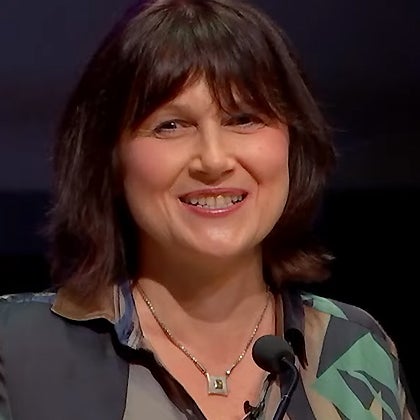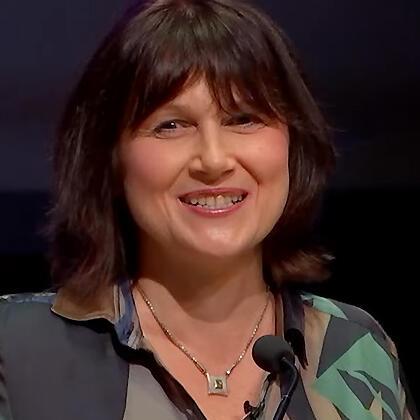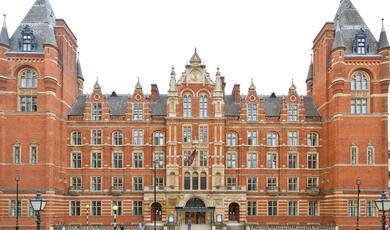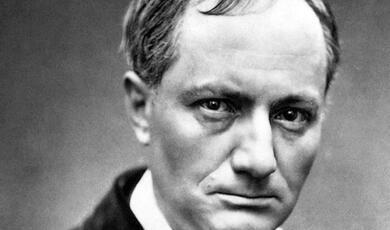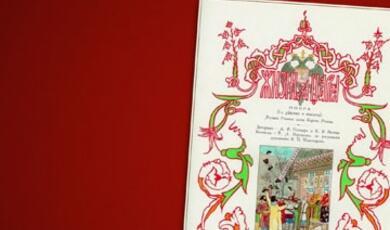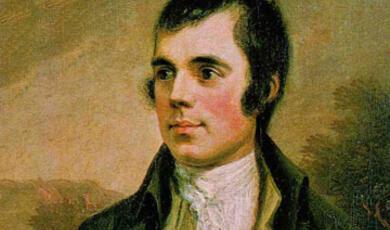How can music be “Socialist Realist”?
Share
- Details
- Transcript
- Audio
- Downloads
- Extra Reading
This lecture will investigate the genesis of the Socialist Realism doctrine, which was imposed in 1934.
The 'proletarian music' trend of the 1920s had offered some solutions to the task of creating 'music for the people', but because it had alienated the most accomplished professional musicians it was now abandoned. A new art music was called for, with potential mass appeal through the use of folk materials and the rejection of modernism.
Download Transcript
The History of the Term
Marxists have generally supported artistic work that is realist. Although Marx did not write on aesthetics, Engels made a fruitful remark that his successors expanded into a theory. The writer Margaret Harkness sent Engels her first novel, and in his reply, he wrote:
“Realism, to my mind, implies, besides truth of detail, the truthful reproduction of typical characters under typical circumstances.”
From the rest of the letter, we find out that his foremost model for literary realism was Balzac, who was middle class, but whose fidelity to realism spurred him to enter generously into the mindset of characters who would be his political antagonists in the real world.
Lenin added to this the notion that since human consciousness reflects the material world, art should do likewise, rather than offering an escape from the world. His model of literary realism was Tolstoy.
The Bolshevik Lunacharsky, future Soviet minister of culture, used the terms “proletarian realism” in 1906 and then “social realism” in 1907, and his main model was Maxim Gorky. In Lunacharsky’s view, Gorky had mercilessly exposed the ills of a (supposedly) decaying bourgeois society from the proletarian point of view. In the 1920s, Lunacharsky also applied the term “new social realism” to “revolutionary artists” in the Soviet Union, in particular those who renounced the modernist tendency towards abstraction and returned to realist figurative painting.
The term “socialist realism”, according to the latest research, first emerged in early May 1932 in a conversation between Stalin and Ivan Gronsky, who had been given the task of re-fashioning the Soviet literary sphere. Gronsky said that he had suggested “proletarian realism”, but Stalin judged this to be too narrow. Stalin’s intention at the time was to create a broad writers’ union that could absorb the various factions that had been in dispute for years. The “proletarian” writers had largely triumphed over their rivals, and so they had most to lose from this development. Stalin had no desire to look as if he was promoting their brand. Gronsky then offered the name “Communist realism”, but Stalin rejected this on the grounds that true Communism lay far in the future. Stalin instead proposed “socialist realism” as a term more appropriate to the project of “building socialism in a single country”. (“Communist realism” would have evoked the spectre of world revolution, which Stalin wanted to play down at this time, for strategic reasons.) And so, Gronsky introduced the term in Literaturnaya Gazeta (23 May 1932):
“We must pose the problem of method, but not in an abstract manner: it is not that a writer must pass a course in dialectical materialism first before he can write. Our principal demand is that writers will write the truth, and truthfully reflect our reality, which is itself dialectical. Therefore, the main method for Soviet literature is the method of socialist realism.”
But in Music?
It soon became clear that this “method” was not just for the writers. The term “socialist realism” was heard in speeches given in meetings across all the arts. Several articles in the (state) press attempted to apply the term to music (by which art music was intended). There was now a Composers’ Union, and its members needed to know what was expected of them. Perhaps the most significant of these was written by Bolesław Przybyszewski, who had directed the Moscow Conservatoire between 1929 and 1932 when it was under the sway of RAPM (Russian Association of Proletarian Musicians). Although he is held responsible for changing the character of the Conservatoire during these years, it is possible that such a figure was needed at the helm for the institution to survive. Przybyszewski was a Party member, a Marxist ideologue but also a man of broad learning and culture. Where his colleagues tended merely to string together the watchwords of the day, he wrote in earnest, and tried to construct genuine arguments.
In the “theses” on music and socialist realism that he published early in 1933, he made several concrete points that composers could adopt, rather than nebulous talk about “method” and “dialectics” that would have left them none the wiser. He tried to show what musical style was implied by the aesthetic of socialist realism. He admitted from the outset that there was a problem:
“In comparison with realism in literature and the other arts, music is greatly restricted in its ability to represent reality.”
This admission must have come as a relief to most composers of the day, who were worried by this time that their role might shrink to writers of anthems for factory workers.
He also introduced the concept of a “musical image”, which left considerable leeway for musicologists and composers to interpret in their own way. Reality, following Lenin, is reflected in a “musical image” which is the main vessel for the required “content” and class ideology. But this “musical image” (according to Przybyszewski) is not reducible to technical devices in music. The music, in technical terms, might use 2/4 march time, a fast tempo, dotted rhythms, trumpet calls, etc. but the image emerging from this could be identified simply as “struggle”.
From this, Przybyszewski extrapolates another concrete point that would again have been welcome to most composers: the new socialist-realist music should be programmatic, but only in a broad sense. What it should reflect from reality is types rather than individual things: “struggle” in general, as opposed, say, to the struggle of steelworkers in Sverdlovsk to meet their production targets. This meant that music did not have to illustrate a text or to follow a detailed (political) programme, which is exactly what the “proletarian” musicians had demanded of their colleagues. Take, for example, Maximilian Steinberg, who, left to his own devices, would have continued composing complex orchestral scores in the tradition of his teacher Rimsky-Korsakov, together with occasional religious works. Instead, under pressure from RAPM, the early 1930s saw him publish his Turksib Symphony “about” the construction of a new railway linking central Asia to Siberia.
Przybyszewski called upon Soviet composers to study the realist music of the past, but again, this was to be understood in such broad terms that little was ruled out other than religious music and Western “bourgeois” modernism (which was dated back to Debussy). After RAPM’s dominance over the preceding years, Przybyszewski’s thesis on realism was a liberation, as it meant that composers would be able to return to many stylistic models that had been ruled out during the previous years.
Finally, Przybyszewski wrote that folk and folk-based art music was highly realist, (onomatopoeia and illustration were the summit of realism, but he had already argued that composers could not restrict their art to these). Many composers were already exploring the folklore of the Soviet Union’s “hundred nationalities”, so this thesis allowed them to continue in this vein in the full confidence that they could now expect official approval.
Not all of Przybyszewski’s proposals were adopted. He considered modern equal-tempered tuning to be “oppressive” and advocated the adoption and cultivation of other tuning systems, such as those which could be found in the national republics. What actually happened was the reverse: folk instruments were “modernised” so that they could be played alongside the piano and other Western instruments. He also proposed that the rhythmic aspect of music should be refreshed through the study of folk music, but this did indeed take place, with Aram Khachaturian as the foremost example. In any case, Przybyszewski’s theses gave musicologists and composers a broad and firm base from which they could develop a modus vivendi with the regime.
The Writers’ Congress of 1935
At the First Congress of Soviet Writers in August 1934, Socialist Realism was officially promulgated. The Congress was a major event and was attended by many Communists and fellow-travellers from abroad. A speech was given, fittingly, by the same Maxim Gorky who had launched “proletarian” or “social” realism three decades earlier.
The most important information, however, was in the speech given by Andrei Zhdanov, the Party’s overseer for the arts. Given the nature of the Congress, he directed his remarks firstly towards literature, but it was understood that they also applied, mutatis mutandis, to the other arts. Here is a summary:
- Subject matter, images, language are to be derived from contemporary Soviet life
- Literature should be optimistic in essence (because it expresses the outlook of a progressive class)
- Writers should not focus on “objective reality”, but rather “reality in its revolutionary development”, i.e., they should have their eye on the brilliant future and not the shortcomings of the present
- They should not be afraid of being “tendentious”, i.e., Soviet literature will always be political
- The call for realism does not cancel out the need for “revolutionary romanticism”: “the supreme spirit of heroic deeds and magnificent future prospects” (this is essentially a call for an elevated tone and monumentality)
- Skill and technique must be cultivated; Soviet art must be of high quality
- Soviet writers should be free to select from the best work of previous eras, because this is the artistic inheritance of the proletariat
Some of these points can easily be applied to music, while others only seem relevant to the texts that could be set to music. A comparable list for socialist-realist music was never drawn up, but from my own research, I can provide the following summary:
- The “inheritance” from the Romantics and Russian classics were the main sources of form and style. The resulting style could be eclectic, and some degree of modernisation was acceptable.
- Neoclassicism, therefore, was permitted (for a while), so long as it sounded more “classical” than “modernist” (Stravinsky was not an acceptable model)
- Optimistic endings were generally required; this was the focus on the communist future
- Musical narratives should be goal-directed, leading organically to the optimistic ending
- Development of material should also be “organic”, as a mark of quality; a “montage” approach required less skill and was redolent of modernism
- The use of folk materials was encouraged, so long as they were not presented in a modernist way (in order to maintain contact with the people, and with reality)
- Virtuosity was encouraged, and the concerto genre remained important – the virtuosity reflected the vitality of the Soviet project of building socialism
- Monumentality and an elevated tone, reflecting the desired “revolutionary romanticism”
- Use of explicitly Soviet topics was commendable, but not required (they could easily become a serious liability with each political change of course)
Although this list of features was never written down in one place, it is not merely my abstraction many years later. Composers had to be vigilant and discerned these socialist-realist features partly from theoretical writings, partly from trial and error, and with clear assistance from the positive and negative examples identified by the composers milieu, by the critics and by the official institutions overseeing Soviet musical life.
Landmark Works
A few pieces were held up as models in the early discussions of socialist realism’s implications for music. One of these was Lev Knipper’s Symphony No. 3, which was dedicated to the Red Army. There is no extant recording of the piece, so I will have to replace it with his Symphony No. 4, entitled “Poem of the Komsomol Fighter”. Fortunately, nothing is lost, since this Symphony followed the same winning formula as its predecessor, in construction, in the use of a Soviet text, and also in the central role of a mass song. In the case of the Symphony No. 4, the song was not already known to listeners at the premiere, but rapidly became famous through its appearance in the Symphony. It is well known in the West as a popular favourite of the old Red Army Choir on its international tours. It was given an English text, and under the title “Meadowlands”, it was sung by Paul Robeson, a prominent American supporter of the Soviet Union. Knipper enters into the genre completely, with a song perfectly suited to a marching army, requiring only three chords for its harmonisation. Knipper himself had military experience, although this was – startlingly – with the Whites in the Civil War, before he changed his loyalties. In the Symphony, the new mass song appears already in the first movement, and long stretches of the work are devoted to it, with the scoring and other aspects of the presentation varied. The parts of the Symphony that do not feature the song are also straightforward for the most part: there is, for example, a battle scene and a funeral march (although there is also a more complicated fugal episode). The changes between different types of music are often very abrupt, and the music often seems to anticipate later developments in film scores.
Knipper’s symphonies were much in demand during the early 1930s, but they failed to pass the test of time. They were interesting as a kind of transition from RAPM music to socialist realism, but as the latter developed and matured, Knipper’s symphonies seemed too primitive, too “illustrative”, and lacking in any sophisticated “organic” development.
Another model proto-socialist realist work of the period was Nikolai Myaskovsky’s Symphony No. 12, which actually dated back to December 1931, the height of RAPM’s power, but it came to be presented as if it was a response to the April 1932 call for socialist-realist art. For those unfamiliar with Myaskovsky’s work, he was a kind of post-Tchaikovskian composer who had earned considerable prestige in Russia; his style was often lugubrious, and by the 1920s, he was beginning to absorb elements of modernism. His Symphony No. 12 has a fascinating backstory: it was commissioned, or at least prompted, by a leading RAPM member, Marian Koval, who was also one of Myaskovsky’s composition students. Here is the concept for the symphony, drafted by Koval on a slip of paper, which was most likely passed to Myaskovsky during the course of a meeting:
“N.Ya. [Myaskovsky’s initials], what would you think of a topic like this for your symphony?
Sowing the seed.
The new men come out to fight nature, not just as individuals, but now as a collective, and their attitude to nature is also different. You could build a symphony out of this: from the sufferings of endless toil through to a joyful and inspired collective construction. This, in my opinion, is a great topic.”
Myaskovsky found himself in a precarious position in the early 30s, like many other artists whose careers were established in pre-Revolutionary times, and who had shown no enthusiasm for the Bolsheviks. When he was suddenly confronted by this When he was suddenly confronted by this opportunity to win favour from RAPM, he decided that prudence required him to accept the proposal, if only with reluctance. Koval wrote him a long and detailed letter, entering wholeheartedly into the role of Myaskovsky’s “political commissar”. He instructed his professor to read Lenin and Stalin, suggested some texts that could be set for choir, and cautioned against some musical and ideological mistakes that Myaskovsky was likely to make. We do not have a record of Myaskovsky’s reaction, but we can detect a degree of contempt for Koval’s presumptious behaviour in the resulting symphony, whose three movements contain no choral settings, and not a word by Lenin or Stalin; there was not even a title about the joys of collectivised agricultural labour.
Koval’s conception of the Symphony, however, was leaked to the public, and the piece was often billed as the “Agricultural” or “Collective Farm” Symphony, even though the score merely presented it as “Symphony No. 12”. In previews and reviews, critics managed to find all the (supposed) details of the collectivisation narrative, from pre-Revolutionary gloom through struggle to the triumph of socialist labour. The bemused Myaskovsky knew it was best to keep his mouth shut and accept the plaudits.
The composer’s tacit acceptance of a vague programme formulated by others actually became a normal part of the socialist-realist culture, and even covers Shostakovich’s and Prokofiev’s symphonies of the 1930s and 40s. This is precisely what Przybyszewski called for in 1933: music should be “programmatic in the broadest sense of the word”, giving a vague sense of a musical narrative that could, if necessary, be explained along socialist lines. Roman Gruber, another musicologist, proposed in 1934 that untexted music might actually be more effective, a more subtle means for conveying class ideology to the listener. After socialist-realist routines had settled down, the programme imposed on Myaskovsky’s Twelfth was viewed as problematic – it was too detailed. Composers found that the best approach was to issue the blandest possible statement, that the new symphony was about the building of socialism, or about Soviet youth. This deliberate vagueness allowed composers a degree of creative freedom, to write music that was rich and varied enough to survive beyond its own times.
My final group of early exemplars in socialist-realist music are several pieces by Aram Khachaturian, who made his name through by showing his Soviet peers that folk-derived music could have high artistic standing. His family was part of the large Armenian community in the capital of Georgia, and he went to Moscow to continue his education; his first lengthy trip to Armenia had to wait until 1939. His style was developed from many sources, including Russian Orientalist music (of Rimsky-Korsakov and others), the Spanish piano music of Albéniz and Granados, melodic and rhythmic idioms from different ethnicities of the USSR (like the Uzbek tune which is used in the finale of the Clarinet Trio), all mixed together with great freedom and no serious concern for authenticity. The concerto genre was his forte: his Piano Concerto (1936) was the work that first brought him to fame in the Soviet Union, followed by his Violin Concerto (1940), which won him international renown, thanks to the advocacy of the violinist David Oistrakh. Oistrakh, interestingly, was deemed to possess a particularly Soviet style of playing, which effectively means he was a “socialist realist” par excellence. He was utterly reliable, seemingly devoid of nervousness or temperamental quirks. His virtuosity was not showy but tempered by good musical sense. His playing was vigorous and communicative and guaranteed to raise the morale of the audience. It was, to use the Soviet word, “life-affirming”.
This made Oistrakh the perfect match for Khachaturian’s music, and the concerto soon won its composer one of the first Stalin Prizes to be awarded for artistic or intellectual achievement (Oistrakh was soon awarded a Stalin Prize in his own right). Khachaturian became a poster boy for the development of the Soviet nationalities and their cultures, although in the long run, this image probably stunted his development as a composer. His music, however, served as a beacon for composers who wanted a safe and sure path to the composition of music that would receive official approval. Similar folk-influenced works make up the highest proportion of music written under Stalin. Every Soviet composer tried his hand at such pieces, and the official visit to some distant region followed by a piece drawing on the local music became a normal element within the composer’s job description.
The Trio we will hear today is an early student piece from 1932, although even here, Khachaturian’s trademark style is in evidence, and he demonstrates that he was a socialist realist composer avant la lettre. Unusual harmonies and rhythms were accepted within this folk-influenced style because of its purported exotic roots; according to the official doctrine, its “realism” was guaranteed by its connection to folk music (no matter how tenuous). In this case, Khachaturian employed an unusual clarinet-violin-piano trio to represent the duduk-kemancha-dhol combination of Transcaucasian folk music. Accordingly, the piano’s role is to provide rhythmic and percussive support for the two soloists, who are often given improvisatory textures. This brilliant piece demonstrates that for some composers, the sudden demand for socialist-realist music did not come as a shock, since they were already cultivating a style that fitted the bill.
© Professor Frolova-Walker 2021
References and Further Reading
A.V. Zakharov, “K voprosu o vozniknovenii termina ‘sotsialisticheskiy realizm’”, Vestnik Sankt–Peterburgskogo Universiteta (2006), Series 2, Issue 1.
Boleslav Pshibyshevskiy, “K voprosu o sotsialisticheskom realizme v muzyke: neskol’ko tezisov”, Sovetskoye iskusstvo (26 May 1933), 2.
Marina Frolova-Walker and Jonathan Walker, Music and Soviet Power, 1917-32 (Woodbridge: The Boydell Press, 2012), paperback 2017.
Marina Frolova-Walker, “’Music is Obscure: Textless Soviet Works and their Phantom Programmes”, in Representation in Western Music, ed. Joshua S. Walden (Cambridge UP, 2013).
Materials of the First Soviet Writers Congress (in English translation): https://www.marxists.org/subject/art/lit_crit/sovietwritercongress/index.htm
References and Further Reading
A.V. Zakharov, “K voprosu o vozniknovenii termina ‘sotsialisticheskiy realizm’”, Vestnik Sankt–Peterburgskogo Universiteta (2006), Series 2, Issue 1.
Boleslav Pshibyshevskiy, “K voprosu o sotsialisticheskom realizme v muzyke: neskol’ko tezisov”, Sovetskoye iskusstvo (26 May 1933), 2.
Marina Frolova-Walker and Jonathan Walker, Music and Soviet Power, 1917-32 (Woodbridge: The Boydell Press, 2012), paperback 2017.
Marina Frolova-Walker, “’Music is Obscure: Textless Soviet Works and their Phantom Programmes”, in Representation in Western Music, ed. Joshua S. Walden (Cambridge UP, 2013).
Materials of the First Soviet Writers Congress (in English translation): https://www.marxists.org/subject/art/lit_crit/sovietwritercongress/index.htm
Part of:
This event was on Thu, 18 Nov 2021
Support Gresham
Gresham College has offered an outstanding education to the public free of charge for over 400 years. Today, Gresham plays an important role in fostering a love of learning and a greater understanding of ourselves and the world around us. Your donation will help to widen our reach and to broaden our audience, allowing more people to benefit from a high-quality education from some of the brightest minds.


 Login
Login
